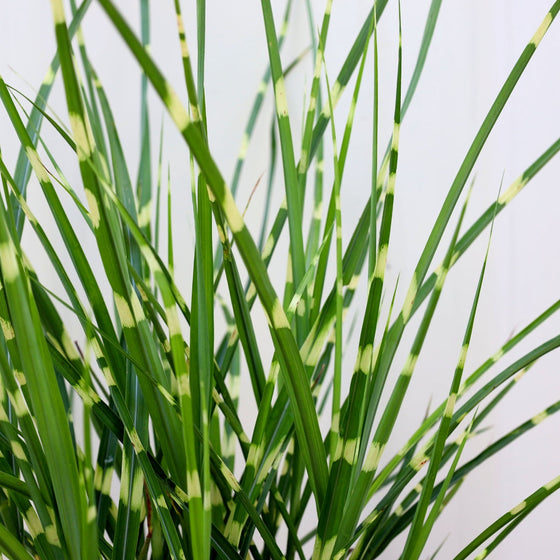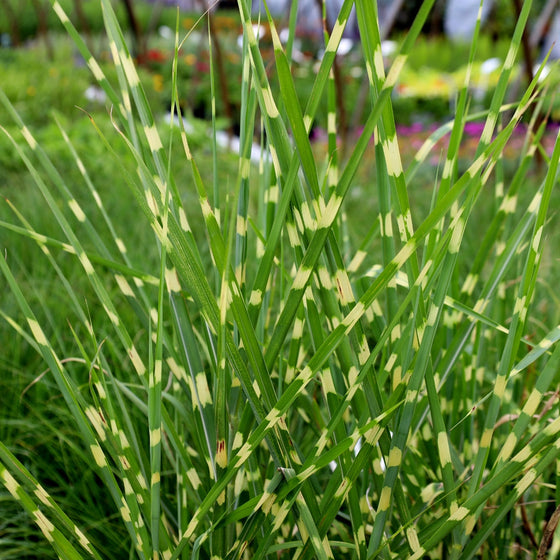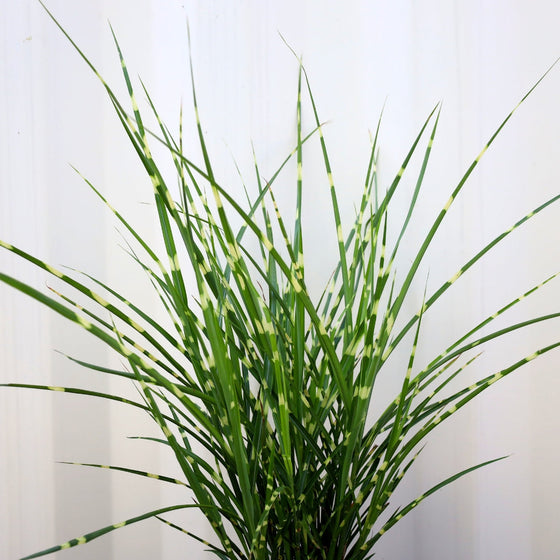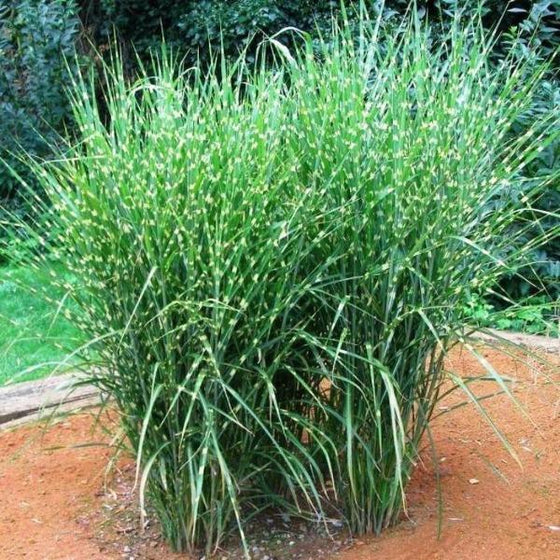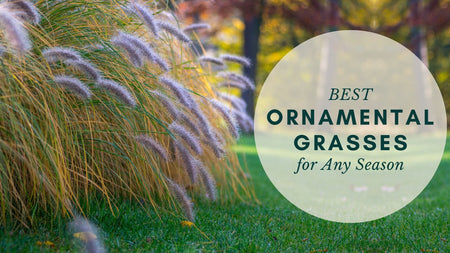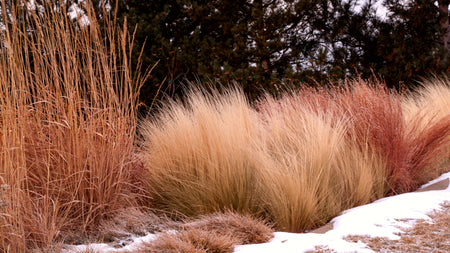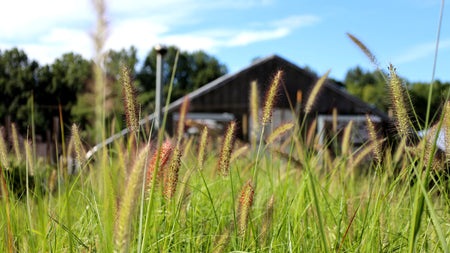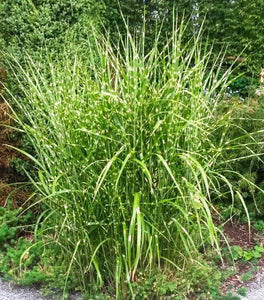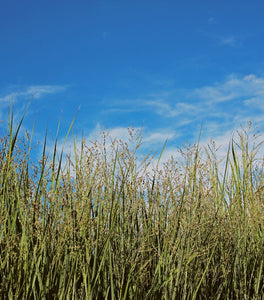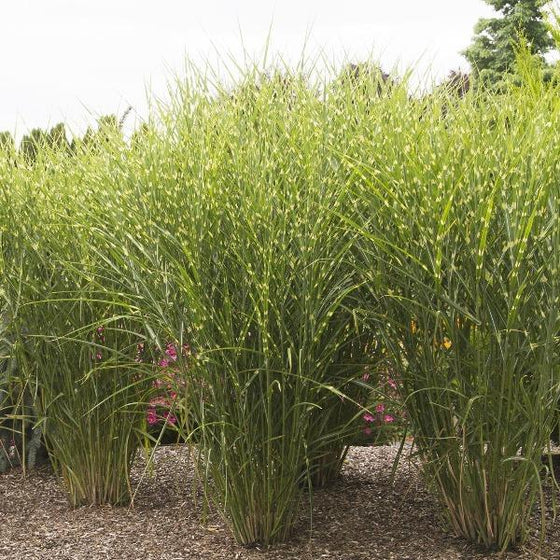
Images Depict Mature Plants
Porcupine Grass for Sale Online
Porcupine Grass (Miscanthus sinensis 'Strictus') is a striking ornamental grass that brings bold texture and color to any garden. This unique grass features tall, upright blades with distinctive horizontal yellow bands, giving it a porcupine-like appearance. The golden variegation creates visual interest throughout the growing season, while the attractive plumes of silvery-white flowers that emerge in late summer add height and movement to the landscape. Ideal for adding structure and vertical interest, Porcupine Grass thrives in USDA Hardiness Zones 5 through 9, making it versatile for a wide range of climates.
Reaching a mature height of 5 to 7 feet and a spread of 3 to 4 feet, Porcupine Grass is perfect for use in large garden beds, as a privacy screen, or as a focal point in borders. Its upright, clump-forming habit makes it an excellent choice for formal or informal designs, providing year-round interest even in winter when its dried foliage remains. This grass is also drought-tolerant once established, making it a low-maintenance option for gardeners looking to reduce water usage. It performs best in full sun and well-drained soil, but it can adapt to a variety of soil types.
In addition to its ornamental value, Porcupine Grass is beneficial for erosion control on slopes or in areas prone to soil erosion. Its dense root system helps to stabilize soil, and its tall, sturdy stems can withstand wind and weather. To keep your Porcupine Grass looking its best, prune back the old foliage in late winter to early spring to encourage fresh growth. Whether planted as a specimen or in mass plantings, Porcupine Grass adds a dynamic and eye-catching element to your landscape.
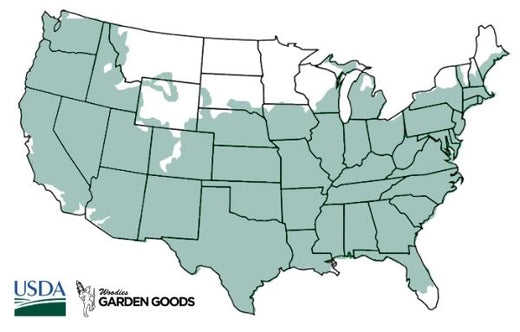
| Hardiness Zone: | 5-9 |
|---|---|
| Mature Height: | 7-8 Feet |
| Mature Width: | 3 to 4 Feet |
| Sunlight: | Full Sun to Part Sun |
| Water Requirements: | Dry to Moist |
How to Care for Porcupine Grass
Be sure to read our planting instructions to ensure a healthy and happy Porcupine Grass for years to come!
How Do I Plant Porcupine Grass?
To plant Porcupine Grass (Miscanthus sinensis 'Strictus'), start by selecting a location that receives full sun, as this ornamental grass thrives in bright light. Porcupine Grass prefers well-drained soil but can adapt to various soil types, including sandy or clay soils. Begin by loosening the soil to a depth of 12-18 inches to ensure good root penetration. Dig a hole that is twice as wide as the root ball and deep enough so that the top of the root ball sits level with the surrounding soil. Place the grass in the hole, backfill with soil, and gently firm it around the base. After planting, water thoroughly to help the roots establish and mulch around the base to retain moisture and suppress weeds. When planting multiple Porcupine Grass plants, space them about 3 to 4 feet apart to allow room for their mature height and spread. Regular watering during the first growing season is essential to help the grass establish strong roots. After the first year, Porcupine Grass becomes drought-tolerant and requires minimal additional watering. It's a good idea to avoid waterlogged soils, as this can lead to root rot. By planting Porcupine Grass properly and in the right location, you’ll enjoy its striking foliage and vertical presence, making it a stunning addition to your landscape.
How Do I Water Porcupine Grass?
Watering Porcupine Grass (Miscanthus sinensis 'Strictus') correctly is crucial, especially during the first growing season, to help it establish a deep and healthy root system. When newly planted, water deeply once or twice a week, ensuring that the top 2-3 inches of soil remain moist but not waterlogged. Watering at the base of the plant is best to avoid wetting the foliage, which can help reduce the risk of fungal issues. This deep watering method encourages strong root development, making Porcupine Grass more drought-tolerant once established. After the first year, Porcupine Grass becomes quite drought-tolerant and requires less frequent watering. During dry periods or extreme heat, it’s important to check the soil moisture and water when the top few inches of soil are dry. Overwatering can lead to root rot, so it's essential to let the soil dry out between waterings. Adding mulch around the base of the plant will help retain moisture and reduce the frequency of watering. Proper watering will ensure that Porcupine Grass maintains its bold, upright growth and vibrant, variegated foliage throughout the season.
How Do I Fertilize Porcupine Grass?
To fertilize Porcupine Grass (Miscanthus sinensis 'Strictus*'), apply a balanced, slow-release fertilizer in early spring as new growth begins. A fertilizer with a 10-10-10 ratio works well to provide the essential nutrients needed for healthy foliage and root development. Spread the fertilizer evenly around the base of the plant, being careful not to place it directly on the crown to avoid fertilizer burn. After applying, water the area thoroughly to help the nutrients absorb into the soil and reach the roots. This spring feeding ensures the grass gets the energy boost it needs to produce its tall, upright stems and striking variegated foliage. For ongoing care, you can also amend the soil with organic compost or well-rotted manure to improve its fertility and structure. Porcupine Grass is relatively low-maintenance and doesn’t require heavy fertilization, so one application in spring is typically sufficient to sustain growth throughout the season. Avoid over-fertilizing, as this can lead to excessive foliage growth at the expense of the beautiful flower plumes. With the right balance of nutrients, Porcupine Grass will thrive, adding height, texture, and movement to your garden or landscape.

How Do I Prune Porcupine Grass?
Pruning Porcupine Grass (Miscanthus sinensis 'Strictus') is essential to maintain its appearance and encourage healthy growth. The best time to prune is in late winter or early spring before new growth begins. Using clean, sharp pruning shears or hedge trimmers, cut back the grass to about 6-8 inches above the ground. This removes the dried foliage from the previous season and makes space for fresh, new shoots. Be sure to wear gloves when handling the grass, as the leaves can be sharp. Regular pruning not only keeps Porcupine Grass looking tidy but also promotes vigorous growth and the development of its tall, upright structure. During the growing season, you can also perform light pruning to remove any dead or damaged foliage as needed. Avoid cutting back the grass during the summer or fall, as this can disrupt its natural growth cycle and reduce the impact of its attractive copper-colored plumes. Allowing the grass to remain uncut through winter adds interest to the garden and provides habitat for wildlife. Proper pruning ensures that Porcupine Grass will continue to add texture, height, and visual interest to your landscape year after year.

